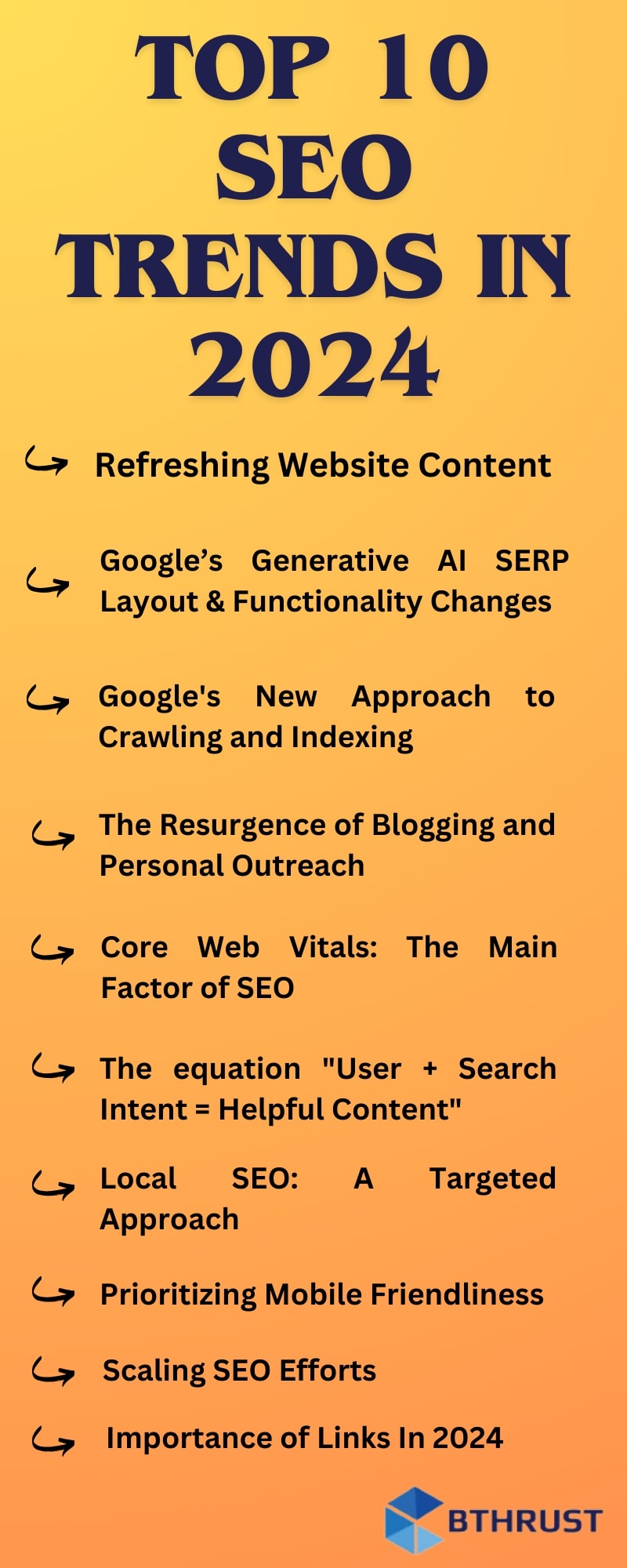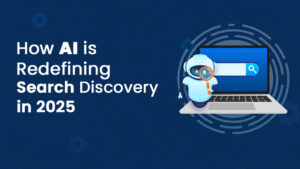This changing digital environment holds companies to task with strategy and search optimization (SEO) to hold a firm seat within the Internet. SEO service is still an important part of this mix, but its strategies and priorities continue to change. This blog shares the latest trends and best practices in website optimization and content optimization for search engines as of 2024, to keep you up with the changing digital landscape and obtain sustained success in your online endeavors.

Refreshing Website Content
One of the pivotal strategies for staying relevant in SERPs is the Regular updating and revising of the content on the website. This practice goes beyond merely adding new articles or blog posts. It involves revisiting existing content and refreshing the old content in terms of making it current, relevant for the market, and still attractive and engaging. In addition to keeping content relevant, updating is about enhancing the user experience and adding value. Which search engines like Google increasingly prioritize.
Here are the key benefits of refreshing website content, as mentioned:
- Secure: Regularly updating your website’s content and underlying technology can help address security vulnerabilities. This proactive approach minimizes the risk of exploitation by malicious actors, safeguarding your website and visitor data.
- Visually attractive: An outdated-looking website can affect user perception. Always continue updating content, design, and the user interface to make sure that your website keeps up-to-date. Which will create and enhance positive impressions and user engagement.
- Search Engine Optimized (SEO): Search engines prioritize websites with consistently freshened-up content because they show continued relevance as a source of current information. Updating your website will signal that its content remains relevant, hence of value, and it may even improve the site’s rank in SERP, bringing in more organic traffic.
- Effective Marketing Tool: This allows you to share valuable information, showcase your offerings or services, and engage with your target audience. By fostering brand loyalty and driving conversions, updates contribute to achieving your overall business objectives.
Google’s Generative AI SERP Layout & Functionality Changes
Google’s potential integration of generative AI algorithms into its search engine infrastructure marks a significant advancement. By leveraging vast datasets, these algorithms can undergo extensive training to comprehend user intent with heightened accuracy. This integration holds promise in revolutionizing search result relevancy, offering users more tailored and precise outcomes. Through sophisticated analysis of user interactions and search patterns, generative AI stands poised to enhance the search experience by deciphering nuanced queries and providing contextually relevant responses.
What are Search generative experiences?
The search generative experiences (SGEs) find and capture the strength of the traditional search engines and the innovative power of generative artificial intelligence (AI). This powerful duo promises to take a whole new level in the way users find and consume information—be efficient at their core, but even more: the experience of engaging, delightful searching. At their core, advanced search systems with the power of Generative AI. Unlike traditional search engines, which can return a list of links in response to just about any query, SGEs are much more. They are like really intelligent assistants who analyze your questions with sharp precision and try to dig into every hidden aim of the question. It extracts exactly the right information from digital libraries and further synthesizes the extracted information with the magic of AI.
When did Google launch SGEs?
Google Search introduced SGE first as an experiment within Search Labs back in July 2023. It was then made available in the U.S., supported with the English language, but now, the support is being added for a wider international release as they have received a warm response.
How do Search Generative Experiences Work?
Query Processing: The processing part is the most essential part that is required to understand what the user has queried, and hence the SGEs start processing. This step uses natural language processing (NLP) to understand the query’s senses.
Information Retrieval: The system then retrieves the information from a wide array of sources. These may include such things as indexed web pages, databases, and other digital repositories. Information retrieval is affected to gain relative material, affecting the scope wide, so the produced output is complete and accurate.
Content Synthesis: Using generative AI models in such a way that the system provides coherent and informative answers. This usually involves noise reduction, finding areas of consistency and inconsistency between the sources, and structuring information in a manner that may be presentable to the user.
Response Generation: Finally, this method applies the generative AI model to produce a response that comprises summarized information, answering the asked question in a conversational and easily understandable manner. This can be in the form of insights, summaries, explanations, or actionable answers.
Benefits of Search-Generative Experiences
- Efficiency: SGEs are efficient in terms of time and energy. They give users answers instead of providing them with links to search through several web pages in search of the needed information.
- Contextual Understanding: The systems leverage context to well understand the query and the user’s intention, hence providing relevant and precise answers.
- Better Experience: Simply put, searching the SGEs gives one a much more interactive and immersive search experience, like you are talking to an assistant who happens to know a lot.
- Aggregate Information from Different Sources: Users can aggregate information from diverse sources on the query topic.
- Accessibility: By converting the responses into natural language, SGEs produce easily accessible information even for a user’s weak point that might not find it easy with the standard search interfaces.
Experience SGEs in your Chrome browser
- Join Search Labs: Join Search Labs to get SGEs among other experimental features.
- Icon Activate Labs: The Labs icon will show up in your Chrome desktop browser if you sign up. It may take a little while.
- Turn on the SGE: Click on the Labs icon and search for the Search Generative Experience. Turn it on.
SGEs make searching for information no longer a drudgery duty but a high-spirited and efficient trip toward knowledge. So, dive in and experience the best.
Dynamic SERP Layout
- Reorganizing search results: No more struggling through irrelevant information. Generative AI could prioritize the results most likely to be helpful based on your past searches and current context.
- Adjusting element size and placement: Tired of ads taking up prime real estate? Generative AI could adjust the size and placement of elements like ads and featured snippets based on your preferences, ensuring the information you seek is front and center.
- Personalization based on user history and location: Looking for the best local restaurants? Generative AI could leverage your location and past search behavior to personalize the layout, highlighting relevant local businesses and reviews.
These dynamic SERPs would essentially create a customized search experience for each user, making information retrieval faster, easier, and more relevant than ever before.
Enhanced Functionality
Generative AI could bring new features to Google Search, like:
- Enhanced Natural Language Processing: A deeper understanding of natural and simple language could enable users to express their queries more conversationally. This covers the way to formulate complex inquiries and receive accurate, comprehensive responses.
- Advanced Visual Search: Utilizing generative AI, users might be able to conduct searches using images or even sketches. The search engine would then analyze the visual input and generate relevant results, catering to a wider range of information-seeking methods.
- Predictive Search Refinement: Through the analysis of user behavior and search patterns, generative AI could offer customized search suggestions. This proactive approach could help users refine their queries and discover relevant information with greater efficiency.
- Personalized Search Interfaces: Generative AI algorithms could potentially personalize search interfaces based on individual user preferences. These interfaces could feature tailored layouts and functionalities, serving the specific needs of each user.
Continuous Learning and Improvement
Google’s search engine results pages (SERPs) powered by generative AI could be designed to continuously learn and adapt through feedback mechanisms and ongoing training on new data. This approach would ensure the algorithms become increasingly effective at delivering highly relevant and personalized search experiences over time.
Google’s New Approach to Crawling and Indexing
The search giant, Google, rethinks its strategy in crawling and indexing websites. It could be a potential move for judicious resource allocation but, at the same time, one would never argue with the fact that it affects the speed of content discovery and ranking from within search results. This is a game-changer for businesses, especially for those whose visibility depends on going strong online.
Crawling and Indexing: The Fundamentals
Before exploring the changes, let’s delve into the core processes involved:
Crawling: Think of the process by which Google is using automated software programs, commonly known as “crawlers.” The Google crawlers crawl from one page to another through links looking for the latest pages over the web, much like the user browsing through links.
Indexing: Once a web page is found, the most important thing that follows is Google “indexing.” This process involves the reading and understanding of the content of the pages, which are then automatically saved in a huge database. Later, when a user supplies a search query, Google uses this index to retrieve the most relevant web pages for the user.
The New Landscape: Efficiency-Focused
Google has brought an interesting twist to the table with this new approach. That approach will bring more emphasis on its crawling and indexing processes’ efficiency. This means websites deemed “crawl-worthy” will receive more regular visits by the crawlers, potentially leading to quicker indexing and hence better rankings of their respective pages within search results.
The Resurgence of Blogging and Personal Outreach
In the context of search engine optimization (SEO), two classics are coming back to life: blogging and personal outreach. Often one might have considered them foundational and maybe outshine some of the newer tactics, but these methods are proving invaluable to keep standing the test of time for both the historic and modern search engine optimization (SEO) landscape.
Relationship Building and Establishing Brand Authority
Blogging: One of the perks of blogging for businesses is that they can display their expertise, deal with pertinent industry trends, and establish business trust with their audience. Such practices allow them to have a consistent base for reading and, therefore, the business is considered a reliable place for its information.
Personal Outreach: Interacting directly with industry influencers, bloggers, and journalists to establish relations and open opportunities beneficial for both parties. These can range from guest blogging and content co-creation to simply joining the line of related industry discussion.
Direct Engagement and Content Sharing – Relevance and Authority in Boosting
Finally, blog content and personal outreach to experts relate to site relevance and authority in the eyes of search engines.
Content Creation: Regular creation of content at a high-quality level that is driven by an active blog and personal outreach to experts signals ongoing activity and signals expertise to search engines.
Backlinks: Building relationships with thought leaders and bloggers within the industry may also provide an opportunity to get valuable backlinks. They serve as a sign of power in your site from other websites and point out to search engines that your content is worthy and valuable.
Core Web Vitals: The Main Factor of SEO
Google’s Core Web Vitals are metrics that are fast becoming key. They alter the focus from abstract technical points to attention on user experience (UX) informed by a website. Core Web Vitals are very important, as they measure key areas of a website that give insights. How effectively a website engages its users, such as loading speed, interactivity, and visual stability.
This is why Core Web Vitals are important.
- SEO Importance: The importance of Core Web Vitals increasingly takes precedence within Google ranking algorithms. Poor scores may seriously reduce the visibility of your site in search and, accordingly, the chances to gain more organic traffic.
- Improved User Experience: Core Web Vitals have a direct bearing on the user experience of any website. For instance, chances are that a website that loads fast, responds sharply to diverse actions from the user, and demonstrates smoothness in the display of content.
- Boosted Conversion Rates: From making a purchase and subscribing to a newsletter to downloading a resource, a good user experience is the key to every conversion. Core Web Vitals optimize and create a user-friendly environment, that users trust, and boosts desired actions.
Optimizing for Core Web Vitals
- Find Areas to Improve: Use tools such as Lighthouse or Google’s PageSpeed Insights to check your website and point out the areas in which the site can be optimized to meet the conditions of Core Web Vitals.
- Elimination of Technical Problems: Addressing image optimization, code minification, and caching implementation can do a great deal to improve site loading speed.
- User-Oriented Design: Ensure that the site layout is friendly and responsive so that users can navigate and interact with the content smoothly.
The equation “User + Search Intent = Helpful Content”
This is whereby a user is out looking for information or a specific answer online. The individual who does this has an intent or question in mind, hence he or she needs to be guided by a search intent that directs online behavior.
Search Intent: This is the underlying intention of a search query made by a user. It works on the premise that one needs to understand what a user is searching for, be it informative content, transactional content to make a purchase, or anything else they might be looking for.
Helpful Content – It is content that appropriately speaks to the search intent of the user, giving information, solution, or value the searcher is looking for. The content is informative, engaging, and satisfies the specific needs of the user.
Why this equation matters ?
By prioritizing the user and their search intent, you create content that:
- You will rank higher: The search engines, Google most importantly, are working to deliver relevant results to users. Now, aligning your content with search intent will be able to, therefore, rank you higher and, hence, get to reach a larger audience.
- Boosts engagement: When users find content that directly speaks to their needs, they are more likely to be more engaged, read further, and probably convert into loyal customers.
- Establishes brand authority: Creating consistently helpful content helps position you as a reliable source of information in your industry, building brand trust and loyalty.
Helpful Content:
Here are some of the tips on how to create the sort of content that corresponds with the user + search intent equation:
- Relevant keyword research: Clearly understand the terms or phrases your audience would type in the search box and fit those keywords into the content where they make sense.
- Focus on user needs: Do not generate content just for the sake of generating it. Identify the areas and questions that your audiences have, and provide them with relevant, direct answers in terms of solutions and information.
- Emphasize quality over quantity: Focus on creating high-quality, informative, and well-written content that provides real value to your audience.
- Optimize for different search intents: Not every search has the same purpose. Be prepared to build up content that answers to a wide range of informational, transactional, navigational, and other search intents.
Why does content matter in 2024?
Content is king in every digital landscape today. It is the blood of your websites, the base of every online marketing strategy, and the key to capturing your target audience and giving life to them. But having content is not enough. To be successful with digital, create useful content that speaks to your user and fulfills their search intention.
Local SEO: A Targeted Approach
It targets some specific area in a different way from the generalized search results, which normally is the focus point in traditional SEO. The most important idea here is that your business is supposed to appear in a very central way in local searches and online maps when users search for given keywords around your area. This is paramount to businesses thriving in foot traffic, like restaurants, shops, and service providers.
Optimizing for Local Success
Several key strategies contribute to a successful Local SEO campaign:
- Claim and optimize your Google My Business listing: This free tool from Google allows you to take charge of the information appearing online about your business. Fill in your listing with complete and correct information, high-quality photos, and convincing descriptions.
- Consistency of NAP: NAP stands for Name, Address, and Phone number. Ensuring that this information shows in the same consistent manner when it appears through different online directories and websites will give search engines a very clear pointing towards identifying and locating your business.
- Positive online reviews: Encourage happy customers to write positive reviews for your GMB listing and other applicable platforms. Positive reviews instill trust and finally develop credibility that influences their purchasing decision.
Benefits of Local SEO: The various benefits include:
- Enhanced Visibility: Being present on local search listings and maps multiply the visibility in front of all those likely customers looking for businesses around them.
- Targeted Audience: Local SEO showcases your business directly in front of interested customers who are actively seeking out what you have to offer.
- Competitive Edge: Ranking in local searches sets you apart from competitors who haven’t made it a priority but more importantly provides you with a strategic advantage in your market.
Prioritizing Mobile Friendliness
There is a mandate for mobile in today’s mobile-first world, as most of the web users draw web access from mobile phones and tablets. In the leading pack is Google, which will downgrade search results of the search engine, together with others, for sites not optimized for mobile. In other words, businesses risk dropping search rankings along with potential customers if their sites are not adapted for mobile viewing.
What is Mobile Friendliness?
It is the design and functionality of a website that adapts flawlessly to screens and many devices. It will include various key aspects:
- Responsive Design: The design of the website adapts automatically to the size of the device screen, giving the best user experience on desktops, tablets, and smartphones.
- Fast Load Times: Minimized page load time on mobile devices to avoid the user becoming irritated and exiting the site.
- Touchscreen Optimization: With buttons, menus, and other interactive features, it is easy to navigate and touch/click them with a finger, unlike a cursor from a mouse.
The following are some of the benefits that come with focusing on mobile responsiveness:
- Improved Search Rankings: Search engines give mobile-friendly websites better visibility in the search done via mobile, which is also where most searches come from.
- Enhanced User Experience: It is easy for users to access and interact with your website contents, hence high engagement and satisfaction levels.
- Reduced Bounce Rates: With a poor mobile experience that frustrates users, bouncing off your website is unlikely, and this helps your conversion rate.
- Capture the Mobile Audience: You effectively reach your target audience by capturing the ever-growing mobile segment.
Scaling SEO Efforts
With the ascent in the ladder of success, the businesses’ Search Engine Optimization (SEO) strategy also needs to ascend. An efficient scale of SEO is, therefore, the managerial key to enhancing and managing online visibility over varied platforms and geographical boundaries.
- Use Analytics and Keyword Research
SEO tools provide valuable data on website performance, user behavior, and keyword trends, among others. Usage of this data helps the writer come up with targeted content, structuring it effectively and hence maximizing its visibility against searched topics.
- Scaling Content Strategies
Develop a content strategy that will address all these diverse markets and, at the same time, be flexible enough to speak to all the diverse needs. It may involve building modular content that can easily be localized or including the region’s variation on existing content.
- Building a Flexible Framework
The ever-changing canvas of search engines makes it imperative for a framework to be in place that is flexible with the growing, algorithmic-changing, and industry-trendy environment.
By scaling their SEO efforts, businesses unlock:
- Increased visibility online: They reach out to a bigger pool of audiences belonging to different platforms and regions.
- Improved organic traffic: The change in content targeting and optimization of the ranking will bring in better-qualified leads.
- Sustainable development: The site would be able to handle upcoming challenges and adapt to an evolving search engine landscape.
Importance of Links In 2024
Search Engine Optimization strategies are dynamic by all means, and adapting all the time is key to following the route of success. But one aspect of the ever-changing ecosystem always seems to be the constant “links”. These digital links serve as valuable support carrying trust from one website to another and relevance in themes. The search engines act like the gatekeepers of online information and, therefore, welcome links. As they form an important part of judgment concerning content quality and topical alignment.
While in the past, the pure mass of links seemed to be in the foreground, things are continuously changing. Here, the strategic approach to link building will necessarily focus on acquisition from reputable sites within similar topical areas.
- Content Expertise: The development of valuable and informative content is likely to attract links naturally and motivate organic linking. High-quality content may enable you to firm your ground as a thought leader and drive organic link acquisition.
- Guest blogging with a strategy: You write guest articles for topic-relevant websites, providing your expert knowledge to a wider audience and bringing valuable backlinks to your site in return. Additionally, such tactics are to be deployed only with strategy; the target website should be on a similar thematic focus as that of your brand.
- Joining in Online Communities: Joining forums and discussions of the industry helps you build useful relations and gives you a chance to express your point of view and expertise. When you are active and a good contributor, sometimes the discussions in such communities can bring you natural links.
Probably, it is a strategic way to how they will build quality and relevant links while focusing on the quality and relevance of the links that are likely to boost the authority and search ranking of their website. This critical and most important part of SEO has always played a role crucial enough in guiding the shifting landscape of the digital world to ensure that the presence of your online brand stays in focus and remains effective.
Conclusion: Navigating the Evolving Digital Landscape
The digital landscape has remained in an evolving space, which demands adaptability from the business if they are to attain online visibility. With all these changes in SEO strategy, the basis of good quality content, technical optimization, and mobile-friendliness is of key importance. New considerations would be Google’s use of generative AI to provide personalized search experiences and a refocus on user intent within content planning. As previously, the profile of strong backlinks remains critical, though it is moving to quality and thematic relevance rather than just the number. Prioritizing the user experience, making valuable content, and fitting into this ever-changing space will ensure a prominent and impactful online presence. But then again, note that success lies in constant learning, putting it into practice, and a commitment to adding value to your target audience.




